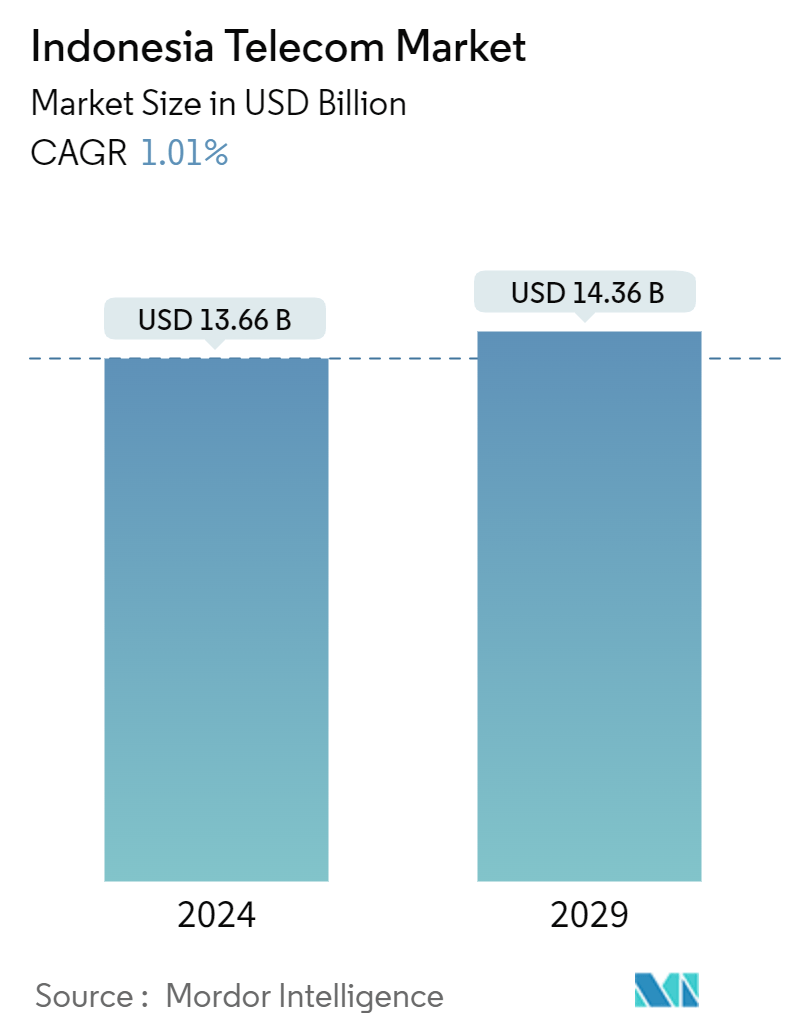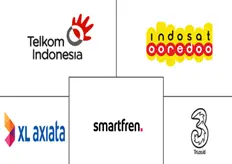Market Size of Indonesia Telecom Industry

| Study Period | 2019 - 2029 |
| Base Year For Estimation | 2023 |
| Market Size (2024) | USD 13.66 Billion |
| Market Size (2029) | USD 14.36 Billion |
| CAGR (2024 - 2029) | 1.01 % |
| Market Concentration | Low |
Major Players
*Disclaimer: Major Players sorted in no particular order |
Indonesia Telecom Market Analysis
The Indonesia Telecom Market size is estimated at USD 13.66 billion in 2024, and is expected to reach USD 14.36 billion by 2029, growing at a CAGR of 1.01% during the forecast period (2024-2029).
The telecom market in Indonesia, which is among the biggest in the world, has plenty of opportunities to expand. This growth has been mainly caused by a possible increase in users. However, it may also be fueled by more revenue per user as the nation's earnings rise.
- The growing demand for high-speed connectivity services by customers and increasing spending on the deployment of 5G infrastructure positively influence the growth of the Indonesian telecom market. With the nation's steady transition into the digital age, the industry has been poised for consistent expansion. By January 2023, GSMA Intelligence reported that the number of cellular mobile connections in Indonesia had reached approximately 354 million, highlighting the extensive penetration of mobile technology within the country.
- Indonesia actively engages with its telecommunications partners to support its transformation agenda. Notably, those aiming to play a significant role in the 5G revolution also supported the nation's tourism initiatives by enhancing its telecommunications networks. As highlighted in an OpenGov Asia report, the Minister of Communication and Information praised the rollout of 5G services, marking it as a key component of the G20 Indonesia Presidency series, aligning with the G20 Summit in Bali.
- Furthermore, in June 2024, PT Telkom Indonesia, in collaboration with SingTel and Medco Power Indonesia, announced plans for a substantial investment. The collaboration aimed to inject IDR 1.4 trillion (about USD 85 million) into the construction of an advanced data center in Batam. This facility was intended to be equipped with Artificial Intelligence (AI) infrastructure, with the project scheduled for completion over a five-year period.
- Telkomsel has been granted a 5G bandwidth of 30 MHz, while Indosat allocated 20 MHz. These allocations are less than the recommended spectrum for an optimal 5G deployment. According to GSMA, an initial allotment of 80-100 MHz for the mid-band was suggested to ensure a robust spectrum. It was noted that more smartphone models were compatible with Indosat's 1.8 GHz band compared to Telkomsel's 2.3 GHz. Given Indosat's focus on the 1.8 GHz band and its initial emphasis on the B2B sector, the demand for smartphones supporting this band is expected to rise, albeit at a moderate pace.
- By the third quarter of 2021, Indonesia experienced a 42% Y-o-Y increase in mobile network data traffic, reaching 78 exabytes (EB), which included traffic from fixed wireless access (FWA) services, according to research conducted by Ericsson. Moreover, recent projections indicated that the total mobile network data traffic was expected to exceed 370 EB by the end of 2027. By the end of 2021, the 88 million registered FWA connections were projected to surpass 230 million by 2027. It is anticipated that approximately half of these connections will utilize 5G networks.
- However, digital disruptions posed significant challenges to the growth trajectory of Indonesia's telecommunications industry. As consumer demands for faster and more reliable connectivity evolved alongside technological advancements, telecommunications operators were compelled to increase infrastructure, IT, and talent investments. Furthermore, the industry’s substantial IT overhaul required significant capital expenditure (CAPEX) and involved extended lead times, further impeding market growth.
Indonesia Telecom Industry Overview
Telecommunications, or telecom, refers to the transmission of information over long distances using electromagnetic signals. The study on the Indonesian telecom market includes a detailed analysis of connectivity trends, focusing on fixed networks, mobile networks, and telecom towers. Telecom services are categorized into voice services (both wired and wireless), data and messaging services, over-the-top (OTT) services, and Pay TV services.
The study also examines the impact of macroeconomic trends on the market and impacted segments. The study also discusses the drivers and restraints likely to influence the market's evolution in the near future. The market sizes and forecasts are provided in terms of value (USD) for all the above segments.
| Segmentation by Services (Coverage to Include Average Revenue Per User for Overall Services Segment, Market Sizes and Estimates for Each Segment for the Period of 2020-2027, and In-depth Trend Analysis) | ||||
| ||||
| Data and Messaging Services (Coverage to Include Internet and Handset Data Packages and Package Discounts) | ||||
| OTT and Pay TV Services |
Indonesia Telecom Market Size Summary
The Indonesian telecom market is a significant player in the global telecommunications landscape, characterized by its vast user base and rapid growth. The sector is poised for continued expansion, driven by increasing digital adoption and rising income levels, which are expected to enhance revenue per user. The market's growth is further supported by the proliferation of mobile connections and internet users, making mobile operators and over-the-top (OTT) applications dominant forces. The government's collaboration with telecom providers to develop infrastructure, such as communication towers and 5G networks, underscores the sector's strategic importance. Despite challenges in spectrum allocation for 5G, the market is witnessing a surge in mobile data traffic and fixed wireless access connections, indicating a robust demand for advanced telecommunications services.
The Indonesian telecom industry is highly competitive and fragmented, with major players like Telkom Indonesia, Indosat Ooredoo, XL Axiata, Smartfren Telecom, and Tri Indonesia leading the market. The sector has seen significant investments and strategic partnerships, such as Telkom's collaboration with Tuya Smart for IoT services and XL Axiata's network expansion in Central Sulawesi. The rise of OTT platforms, fueled by affordable smartphones and improved internet access, has transformed the entertainment landscape, with platforms like Disney+, Netflix, and Vidio gaining substantial user bases. The market's growth is further bolstered by international investments, such as Alibaba's stake in Smartfren Telecom, highlighting the sector's potential for continued expansion and innovation.
Indonesia Telecom Market Size - Table of Contents
-
1. MARKET INSIGHTS
-
1.1 Market Overview
-
1.2 Industry Ecosystem Analysis
-
1.3 Industry Attractiveness - Porter's Five Forces Analysis
-
1.3.1 Bargaining Power of Suppliers
-
1.3.2 Bargaining Power of Consumers
-
1.3.3 Threat of New Entrants
-
1.3.4 Threat of Substitute Products
-
1.3.5 Intensity of Competitive Rivalry
-
-
1.4 Impact of Macroeconomic Trends on the Market
-
1.5 Regulatory Landscape in Indonesia
-
-
2. MARKET SEGMENTATION
-
2.1 Segmentation by Services (Coverage to Include Average Revenue Per User for Overall Services Segment, Market Sizes and Estimates for Each Segment for the Period of 2020-2027, and In-depth Trend Analysis)
-
2.1.1 Voice Services
-
2.1.1.1 Wired
-
2.1.1.2 Wireless
-
-
2.1.2 Data and Messaging Services (Coverage to Include Internet and Handset Data Packages and Package Discounts)
-
2.1.3 OTT and Pay TV Services
-
-
Indonesia Telecom Market Size FAQs
How big is the Indonesia Telecom Market?
The Indonesia Telecom Market size is expected to reach USD 13.66 billion in 2024 and grow at a CAGR of 1.01% to reach USD 14.36 billion by 2029.
What is the current Indonesia Telecom Market size?
In 2024, the Indonesia Telecom Market size is expected to reach USD 13.66 billion.

